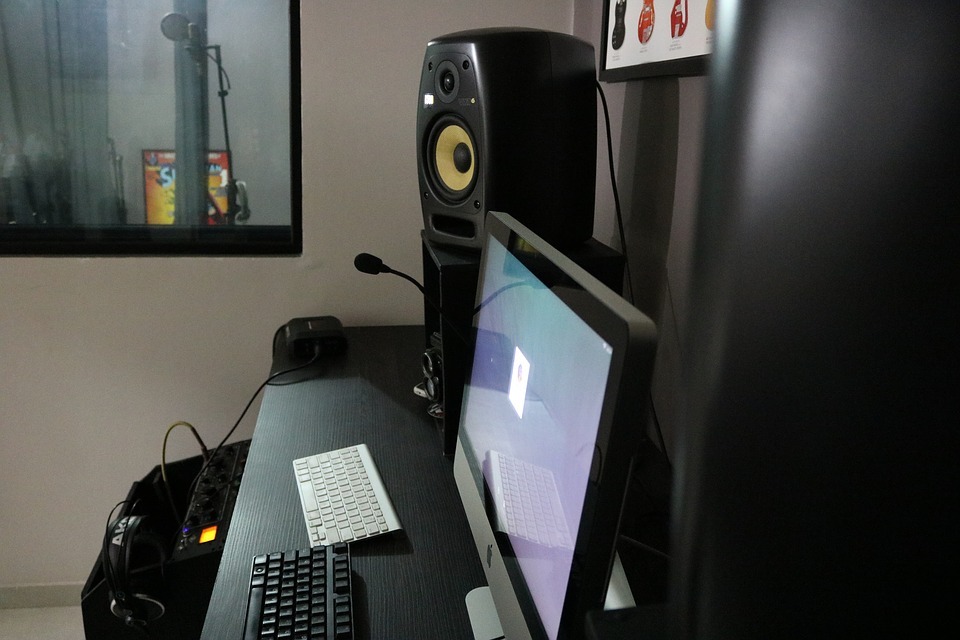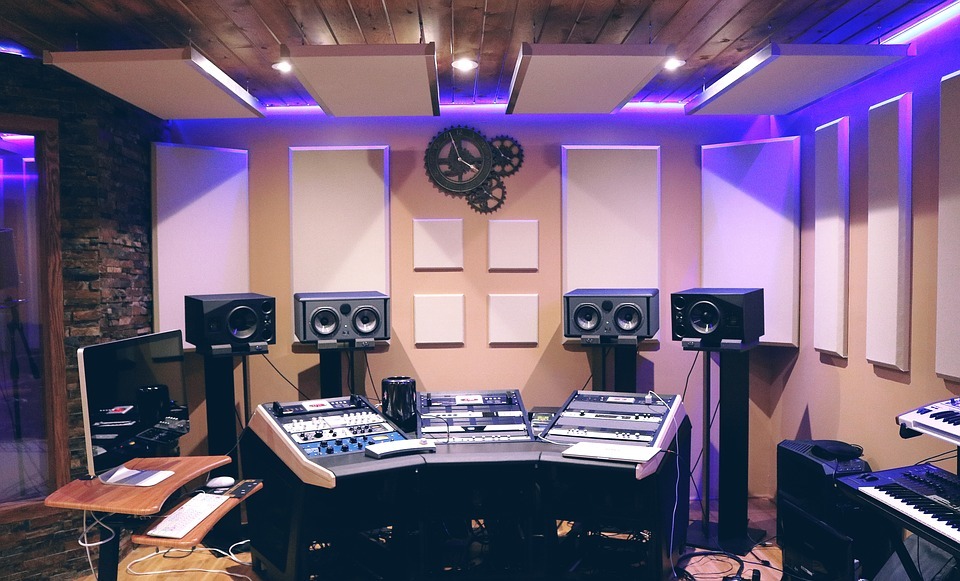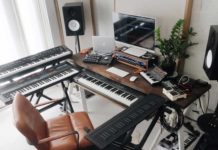Studio monitors are basically loudspeakers in a speaker enclosure which have been made especially for professional studio setups. They are specially designed for purposes of studio recordings, film making, radio studios, home studios, etc.
A studio monitor is important in instances where accurate sound reproduction is of the essence.
The term ‘monitor’ is attached to the speaker because the speaker is meant to produce a relatively flat or linear phase and frequency response.
To put it simply, the loudspeaker gives a more accurate reproduction of the tonal qualities of the audio than regular speakers. This is important because this will allow the sound emitted to be without distortion during stereo recordings. You will be able to hear every note that has been emitted when the sound is played back, therefore, allowing you to edit the sound with all the information in hand
There is a better chance of you mixing a good track when you can hear the sound without any distortions on the edit table. When this does not happen, people often hear misses and errors in the track they have mixed when they play it back later from a regular speaker.
The following is a brief guide to studio monitors and why they are important to get that perfect quality of sound in a professional recording, even if it is done at a home studio. You will be taken through the size of studio monitors, the different types that you can pick from, the preferred frequency range, etc.
Read on to find out more about studio monitors and why they are important for perfect sound quality in your recording.
Studio Monitors vs Regular Speakers
There is a world of difference between the audio produced by studio monitors and the audio produced by regular speakers. As has been described above, studio monitors are meant to produce a flat frequency response which is as close to the original audio source as possible.
There should not be any coloration to the sound when it is replayed.
This is important especially for sound recording as the sound emanating from the speakers should not influence how the sound is edited by the audio professional.
In comparison, powered speakers or regular speakers are meant for personal use and purely for the pleasure of listening to audio. This is why a powered speaker may sometimes be designed in a way that the audio is altered in order to provide a better, if not always authentic, sound quality.
You will not be able to tell the difference just by listening to it a few times, but a trained ear will be able to catch the disparity.

There is also a difference in the projection of the sound.
While regular speakers are meant to spread the sound in the whole room, a studio monitor is meant to direct the sound only at the audio engineer so they have all the sound data when they are editing it.
They have been designed for a smaller space so the audio is not lost when it needs to travel through a larger room.
Some examples of companies that manufacture quality regular speakers are:
- Proreck
- Rockville
- Klipsch
- Edifier
- Mackie
Meanwhile, some of the best companies for studio monitors include, but are not limited to:
- JBL
- Neumann
- Adam
- Yamaha
- KRK
- M-Audio
Best Studio Monitors & Speakers for Recording Studios
Check out the best studio monitors on the market: we review the cheap and high-end speakers for music-makers in their professional or home recording studios.

Monitor Size and Room Size
A studio monitor comes in a variety of sizes but there is no standard size that is suitable for everyone. There is also a general perception that the bigger the studio monitor, the better the quality of the sound. This is not necessarily true.
Sure, a large studio monitor will have greater control over the sound and will probably even be more faithful to the frequency response.
If you are occupying a small room, there is no point in using a large speaker as the audio will only be wasted. You might want to look into some quality studio headphones in this case.
The idea is to get the truest sound possible, but if the sound monitor is too big for the room, then there is a good chance the audio engineer will be missing out on some of the important notes.

Your best bet at finding a studio monitor that you like is to pick a size in accordance with the size of your room.
If you are using the monitor in an average-sized spare room at home or in smaller space than, say, a living room or a master bedroom, a pair of 5-inch studio monitors should be a good fit for you.
If you have a bigger room or, say, you have converted a larger basement into your studio, you may want to push more air with a pair of 8-inch studio monitors.
There is no hard and fast rule about this but through these examples, you, perhaps, get a better idea of how to make a more suitable purchase.
Think of the size of the room you will be placing the studio monitors in and then pick a size accordingly.
3 Types of Studio Monitors
There are a few different types of studio monitors that you can pick from. Given the choices, you may feel a bit confused about which device might be better for you, but the following section will try to give you a low down of the different types of monitors.
You will find out more about at least three different types of monitors:
- Near-field and far-field monitors
- Active and passive frequency range monitors
- Ported and unported monitors
Let’s deep dive into what each of these has to offer:
Near-field vs Mid-field/Far-Field Monitors
Near-field monitors are those which have smaller drivers and are required to be placed closer to the listener. Sitting close to the monitor means the direct sound will reach the listener’s ear instead of reflecting off other surfaces in the room.
Near field monitors ensure you get the truest, most untainted sound from the feedback monitor, reducing the impact of the room’s acoustics to a large degree. The true quality of the sound allows the audio engineer to catch any niggling errors in the sound and perform more detailed work during the edit.
Near-field monitors also have a narrower frequency response. The sound emanating from the loudspeaker will be closer to how it may sound on a consumer monitor.
It will, therefore, be a more accurate representation of the kind of experience an average listener may have while listening to the sound.
On the other hand, far-field monitors have larger drivers and need to be placed further away from the listener. They are, typically, placed on the perimeter of the room, either mounted on a wall or behind the mixing desk.
These monitors work best in rooms where the natural acoustics will enhance the sound. The idea of using the entire space in the room is to also be able to hear the low frequencies which have a longer wavelength and need more room to travel and come back to the listener.
A far-field monitor will provide the listener with a more dynamic experience and the audio or editing engineer would be able to tell how the mixed track is sounding on the whole.
Which one you should get depends on the type of studio you have:
- For a home studio with limited space, a near-field monitor seems to be the best bet as you will not be able to hear the low frequencies in a small room as it is, so there is no point in spending money on buying larger monitors.
- For a professional studio, or even a home studio, where you have more space, a far-field monitor should work beautifully and if you can afford it, you should certainly invest in one.
Active vs Passive Frequency Range
There are also different monitors that have an active frequency range and a passive frequency range.
A passive monitor is one that needs an external amplifier that is able to amplify the input signal before it is entered into the monitor. The amplified signal is then sent over something called the crossover network, which acts as a filter and is able to separate multiple signals from the input based on their frequencies.
In a studio monitor where there is one tweeter and one woofer, the crossover network creates two signals — with higher frequencies and lower frequencies. The higher frequencies go to the tweeter while the lower frequencies go to the woofer. This whole setup is known as the single-amp system, which means the output of one amplifier is divided by the crossover network and transmitted to the drivers.
An active monitor is one that does not need any external amplification. The amplifiers are pre-installed in the monitor cabinet and come with loudspeakers. When the input signal enters the monitor, it passes through the crossover network and then each signal is amplified separately before they are transmitted to the relevant drivers.
In a studio monitor with one tweeter and one woofer, the signal would be split into two bands and each band would be amplified separately. This is known as the bi-amp system.
In some systems. People are known to introduce a third speaker so the signal can be split into low, mid and high frequencies. All of these bands would be amplified separately and the setup is called a tri-amp system.
When it comes to the quality of sound, bi-amp and tri-amp systems have better quality as the drivers are powered individually, making the sound more precise.
Again, which one you should get depends on the type of studio you have:
- Active speakers are better and more convenient in an intimate, home studio setting. You do not need to invest in a separate amplifier and you will be able to save on space as well as money. A passive system also means you need to calibrate the amplifier to your monitor’s driver.
- You can use a passive system in a studio where you have more space as you will be able to accommodate a separate amplifier. This is a more expensive setup, however, as has been mentioned before, bi-amp and tri-amp systems may give you a similar or perhaps even a better sound than single-amp systems.
Ported vs Unported
When a monitor has holes, it is called a ported monitor and one without holes is called an unported monitor. When a driver vibrates, it creates a movement that triggers internal air pressure within the cabinet. Depending on whether the monitor has ports or not, the air pressure is dealt with accordingly.
The ports can redirect the air pressure outside the cabinet. With the help of these ports, the air resonates closer to the monitor’s cutoff frequency, which in turn is able to help extend the frequency response of the monitor. This allows the monitor to play more low frequencies than an unported monitor.
Does this mean that ported monitors are better than unported monitors? No, not necessarily. Unported monitors that are well-calibrated can also offer a better bass response. Besides, a cheap ported unit may do more harm than good and create too much resonance at the port than the sound requires.

Which one you should get depends on the type of studio you have:
- If the ports are located in the back of the cabinet, the drop inaccuracy will be way more apparent. This becomes worse if the speakers are placed close to a wall as the signal will hit the wall and create even more resonance. If you have a small home studio, this is likely to be a problem.
- You can opt for a front-facing ported speaker if you have a small studio but are still looking for a ported unit. Front-facing ports will ensure the signal does not bounce back after hitting the wall.
- An unported unit will give you much greater accuracy, especially in a small studio. If you have a small space, an unported monitor may be a better option for you.
How Much Wattage Is Recommended
There is a perception that a studio monitor’s power wattage is directly linked to the maximum volume it can provide. It makes sense that laymen think this, but it is certainly not the case.
When you have a higher wattage, it also means that the sound you get will be far more detailed, giving you greater control over the sound with lesser distortion.
The more expensive your monitor, the greater the wattage typically tends to be.
Cheaper monitors have lower wattage, which means that the high and low frequencies tend to be distorted as the monitor has trouble coping and cannot provide you with the required output.
High bass levels are particularly problematic to play on low-wattage monitors so depending on the kind of sounds you need to play and input, you need to select a speaker with appropriate wattage accordingly.
If you are working out of a home studio, you typically will not need a very powerful system.
Home studios are fairly small and you can be perfectly happy with a sound that isn’t as defined as there is a lesser chance of distortion, since the sound will be traveling through a smaller space.
A bigger room, therefore, will require greater wattage because more power is required to fill the room and give you a more accurate sound. On average, people with home studios seem to be happy with studio monitors that start at 50 watts.
Ideal Frequency for Specific Genres
Different genres have different requirements when it comes to studio monitors.
The sound of different genres can be radically different so a monitor that is great for editing R&B tracks may not be as useful or as accurate when representing the sound of a rock song.
As an audio editor or engineer, you may work with a different variety of genres and tracks so it would be difficult to select any one genre-based on which you should invest in a studio monitor. But if you do have a genre you think you will be dabbling into more frequently than the rest, it would be wise to pick a studio monitor with a frequency range and wattage that is suitable for that specific genre.
The following are the requirements you may have for a few specific and popular genres:
- Hip-Hop: For a hip-hop track you need a studio monitor that has a broad frequency range and preferably a high wattage. You need a monitor that has proper functionality levels and that also offers accurate low ends so the bassline and drum loops can be edited with greater accuracy. Here are some of the best studio monitors you can use for recording a hip-hop track.
- Rock: A rock track will also need a studio monitor with a broad frequency range and a high power wattage. You may also need to add woofers that are large and powerful enough to support all the low, mid and high frequencies a rock track may comprise. An 8-inch woofer for the monitor is a good place to start.
- Acoustic: Now, this is a very broad adjective for a genre. There can be acoustics even in a rock song but if you focusing on softer ballads or are working with vocals, the sound does not require as much from the studio monitors. For light audio work, you can use a simple near-field studio monitor that is supported by a 4-6-inch studio monitor. Here are some of the best near-field studio monitors you can consider.
As has been mentioned above, it is not at all easy to narrow down a specific genre for which you should buy a studio monitor. But if you have a clear idea of the genre you may work with more frequently, the decision may be easier to make.
Every studio monitor may have something good to add to a sound but the basic thing to remember is that the genres that have greater lows and require more power to play the low ends with greater clarity will need a studio monitor with a broader frequency range and a higher wattage.
The genres that are not as taxing on the monitor and have lighter sound notes that do not require a powerful bass response can make do perfectly with a studio monitor that is small, near field and has an active frequency range. The decision is yours to make.
Final Thoughts
A studio monitor is of utmost importance in the life and career of a musician and an audio engineer.
If you are looking to create a sound that is dynamic and interesting, you need to have all the information at hand when you are editing that sound. So if at the mixing table you cannot hear all the notes accurately, you will not be able to create a mix or a track that lives up to its fullest potential.
There may be notes and audio signals that get distorted and you may think you are editing a certain kind of track but it may end up sounding like something else when you actually play it back.
If you miss out on the details of the sound on the edit table, that is an opportunity lost.
Even if you are an amateur sound designer or run a small home studio, it still doesn’t mean that you need to compromise on the quality of the sound. You can still invest in a studio monitor that is suitable for your budget and suitable for the studio space you have.
There are plenty of options out there that are suitable for small and intimate home studio spaces and the best part is that they do not rip a hole in your pocket or break the bank.
You can whip up a perfect track with minimal distortions in sound and with the truest representation of the original source of the sound.
Regardless of the sound you want to create or the studio you have managed to set up, there is a studio monitor out there waiting for you to mix those perfect tracks.










![5 Best 61-Key MIDI Controllers [Reviews & Buyer’s Guide] Native Instruments Komplete Kontrol S61 MK2](https://homestudiohub.com/wp-content/uploads/2020/03/null-32-80x60.jpeg)

